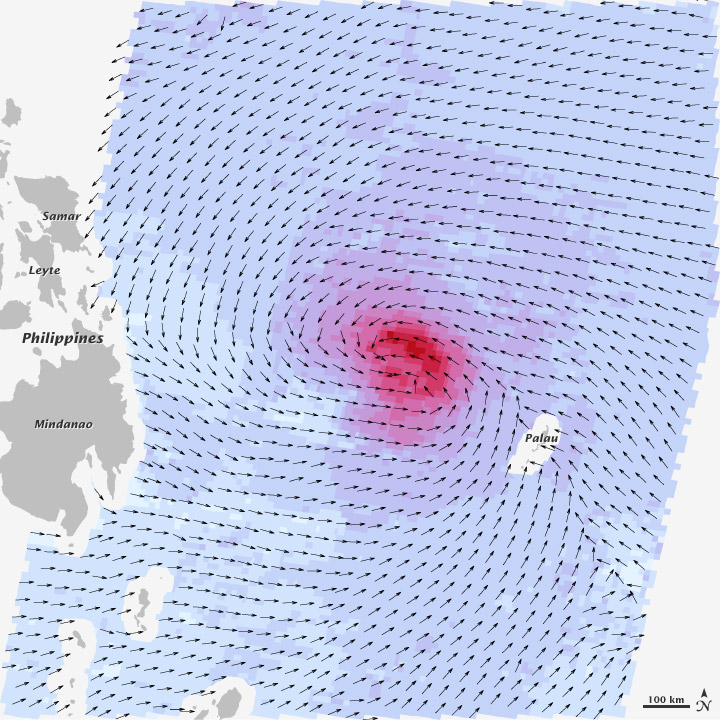NASA: Philippines - Palau - Assessing Haiyan’s Winds - 11.12.13
Posted by Ricardo Marcenaro | Posted in NASA: Philippines - Palau - Assessing Haiyan’s Winds - 11.12.13 | Posted on 20:44

acquired November 6, 2013
In the absence of direct wind speed
measurements, one of the common methods used to estimate the intensity
of tropical cyclones is the Dvorak technique.
Developed three decades ago by American meteorologist Vernon Dvorak,
the technique estimates maximum wind speeds by analyzing subtle
differences in visible and infrared
satellite imagery. However, the Dvorak method does not directly measure
a storm’s winds, and some meteorologists think it overestimates maximum
wind speed in some circumstances.
Since meteorological organizations do not send hurricane hunter aircraft
to monitor typhoons and cyclones in the Pacific—and few ground
instruments survived the storm—the Joint Typhoon Warning Center and
other groups had to rely heavily on the Dvorak method to estimate wind
speeds for Super Typhoon Haiyan. As meteorologist Eric Holthaus pointed out, the storm even surpassed the maximum of the Dvorak scale, scoring higher than an 8.0 on an 8.0 scale as Haiyan approached the Philippines on November 7.
Scatterometers,
a type of microwave radar, can also measure the strength of a storm’s
winds. The dual-beam rotating scatterometer on the Indian Space Research
Organization’s Oceansat-2
satellite, for instance, can be used to measure the strength of the
winds at the ocean surface. On November 6, 2013, Oceansat-2 measured
Haiyan’s surface winds at 9:30 a.m. local time (5:30 p.m. PST), as shown
in the image above. Arrows indicate wind direction and colors indicate
wind speed, with darker shades of purple indicating stronger winds. (The
strongest are red.) As is typical of cyclones in the northern
hemisphere, the area of strongest winds was northeast of the storm center.
According to the Oceansat-2 data, which was processed by scientists
at NASA’s Jet Propulsion Laboratory (JPL) using an experimental
technique, the storm’s winds peaked between 190 and 300 kilometers (120
and 128 miles) per hour at the time of measurement—strong enough to devastate the landscape.
However, it is important to note that the maximum winds were likely stronger than what Oceansat-2 measured, explained Bryan Stiles
of JPL. His group’s algorithm averages Oceansat-2 data over a 24 by 24
kilometer (15 by 15 mile) area, which yields a value somewhat lower than
the storm’s absolute maximum winds. Stiles estimated that the maximum
wind speeds were probably about 20 percent faster—about 240 kilometers
(150 miles) per hour—when Oceansat-2 acquired the data, but his team has
not yet had time to perform a rigorous analysis.
“The resolution of scatterometers is usually around 15 to 30 miles
(25 to 50 kilometers), so they are not capable of resolving a storm’s
maximum winds,” explained University of Miami meteorologist Brian McNoldy.
“They work on the principle of wind roughening the ocean’s surface. So,
in a sense, they don’t really measure the wind in a tropical cyclone.
What they do is detect differences in how radiation is scattered off the
ocean surface, and then a complex model is used to back out what wind
speed would be responsible for that amount of roughness.”
“The bottom line is that meteorologists are going to be debating what Haiyan’s top wind speeds were for some time,” said Jeffrey Halverson,
a meteorologist at the University of Maryland at Baltimore County. “The
best we can do is point to the strengths and shortcomings of each piece
of technology or technique that we use to estimate winds—be it Dvorak, a
scatterometer, or a barometer. Since we lack reliable in situ measurement for Haiyan, we have to use wide error bars.”
Further Reading
- NASA Earth Observatory (2012, October 28) Comparing the Winds of Sandy and Katrina. Accessed November 11, 2013.
- NASA Jet Propulsion Laboratory Oceansat-2 Scatterometer Level 2B Ocean Wind Vectors in 12.5 km Slice Composites, Version 2. Accessed November 11, 2013.
- item two
- NASA Jet Propulsion Laboratory (2013, November 8) NASA Peers Into One of Earth’s Strongest Storms Ever. Accessed November 11, 2013.
- New Republic (2013, November 11) How Strong is Super Typhoon Haiyan? Accessed November 11, 2013.
- NOAA What is the Dvorak technique and how is it used? Accessed November 11, 2013.
- Business Insider (2013, November 8) Missing Data Means We May Never Know The True Power Of Super Typhoon Haiyan. Accessed November 11, 2013.
Data courtesy of the Jet Propulsion Laboratory and the Indian Space Research Organization’s Oceansat-2 mission. Caption by Adam Voiland, with information from Alexander Fore, Brian McNoldy, and Bryan Stiles.
- Instrument:
- OceanSat-2 - OSCAT
NASA: Philippines - Palau - Assessing Haiyan’s Winds - 11.12.13
You have an alphabetical guide in the foot of the page in the blog: solitary dog sculptor
In the blog: Solitary Dog Sculptor I, the alphabetical guide is on the right side of the page
Thanks
Usted tiene una guía alfabética al pie de la página en el blog: solitary dog sculptor
En el blog: Solitary Dog Sculptor I, la guia alfabética está en el costado derecho de la página
Gracias
Ricardo M Marcenaro - Facebook
Blogs in operation of The Solitary Dog:
solitary dog sculptor:
http://byricardomarcenaro.blogspot.com
Solitary Dog Sculptor I:
http://byricardomarcenaroi.blogspot.com
Para:
comunicarse conmigo,
enviar materiales para publicar,
propuestas comerciales:
marcenaroescultor@gmail.com
For:
contact me,
submit materials for publication,
commercial proposals:
marcenaroescultor@gmail.com
My blogs are an open house to all cultures, religions and countries. Be a follower if you like it, with this action you are building a new culture of tolerance, open mind and heart for peace, love and human respect.
Thanks :)
Mis blogs son una casa abierta a todas las culturas, religiones y países. Se un seguidor si quieres, con esta acción usted está construyendo una nueva cultura de la tolerancia, la mente y el corazón abiertos para la paz, el amor y el respeto humano.
Gracias :)


Comments (0)
Publicar un comentario